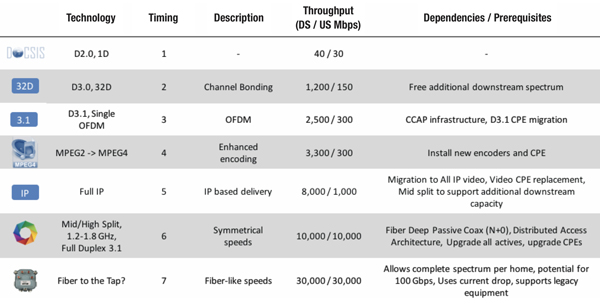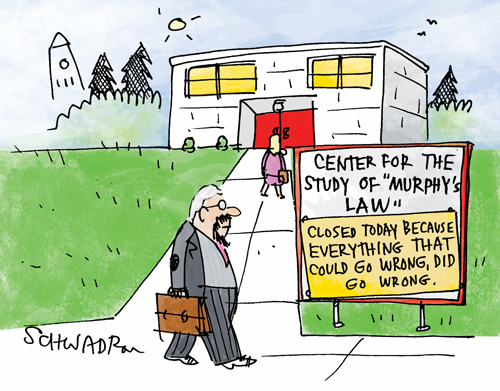It’s all about Spectrum
By Jeff Finkelstein
Based on comments I have received regarding my spring column, SOS (shiny object syndrome) is a systemic issue not only in the service provider industries, but also across a diverse range of business fields where technology plays a significant part. While I would not label it strictly a technology-based problem, it is the basis of how many companies enhance their product sets by using new and advanced technologies to drive improvements to customer experience, enticing us to upgrade early in the lifecycle of the previous generation of equipment. Ultimately the challenge lies with us as technology consumers and our never-ending quest for perfection in the equipment we use to deliver and support services, and to provide new and exciting products to our customers.
I was speaking at a conference recently and a significant portion of the conference was spent presenting on topics related to new technologies that while undeniably cool and exciting, are still 5-7 years away from mass deployment, depending on to whom you are speaking about them. The “new and improved” moniker has thought-provoking implications. First, “new” implies that what we have today is old in comparison, while “improved” could be taken to mean that what we are deploying has things that need to be improved upon. If something is “new” is it not “improved”?
To our customers that is often not the case at all. The technologies in use are working just fine and customers do not see a reason to change. In fact, they often find the change disruptive and need to learn new ways to access things that they only recently had to relearn from the previous technology paradigm shift.
A real-world example is that as I am writing this in a New Orleans hotel my flight was cancelled due to bad weather in my home of Atlanta. I went to use my airline app which was automatically upgraded last night, and the airline at the same time upgraded their reservation software. The upgrade to the mobile app was broken and did not show my flights for the same day of travel, and the reservation system no longer automatically updated the choices for the agent. This meant longer call times as they now had to do everything manually while you waited on the phone. Longer call queues, delays, and fewer choices as flight availability did not always show up on the agent’s screens. The chaos that ensued made national headlines.
New and improved? Maybe. Better? Hardly. Customers who were dissatisfied? Absolutely. Did it make sense to upgrade all the software at once? Not working for the airline I would not know, but what I do know is it took 60 minutes to make a change that previously I could have done on-line in a few taps.
In the end, Murphy’s law ruled with “if anything can go wrong, it will.” But Jeff’s corollary to Murphy proved equally true. “If anything can go wrong, it will, but also that it likely already has, just that no one has noticed it yet.”
Access Network Evolution Part 1
As a refresher, below is the graphic I first showed in the Spring 2017 issue of Broadband Library.

The purpose of this chart is to lay out a “North Star” for a multi-year technology strategy. The chart does not give absolutes, it just provides the general direction where things need to be headed. As I previously pointed out, the chart includes no specific dates, no financials, and no vendor information. The goal is to show what technologies we plan on using, what is the sequence of execution, a description of the results, the data rates enabled by the technology, and what are the dependencies needed to enable the technology at each stage. To reach a consensus with the business, product and technology teams, you need to run models with very specific dates, financials and vendors, but for showing the general direction of technology futures a simplified chart helps drive the key points home with the audience.
Where’s the Beef?
In many organizations, there are people whom one of the future thinkers of our time, Phil McKinney, President of CableLabs, calls “corporate antibodies.” Here is what Phil says in his book …
“Much as antibodies in our immune system attack and destroy foreign objects that might harm the body, ‘antibodies’ in your organization identify and neutralize forces that threaten to destabilize a company. And in much the same way as antibodies can damage the very thing they seek to protect — for instance when they cause the body to reject a transplanted organ — corporate antibodies can stunt a company’s growth (and not address the innovators dilemma) when they shut down the fresh ideas and unconventional thinkers it so badly needs.” — Phil McKinney, author of Beyond the Obvious: Killer Questions That Spark Game-Changing Innovation
While Phil is specifically talking about those who shut down innovative ideas, I believe we can apply the same logic to those who try to shut down technology roadmaps by throwing roadblocks in the path. I’m not going to dig into the psychology of the antibodies and ways to deal with them, I simply want to point out that as you do your technology roadmap there is an expectation that some will try to block the path with different methods.
Here is a list of things I have heard, and think some will resonate with you as well…
- “We already tried that and couldn’t make it work.”
- “What we’re doing has worked fine for years; there is no need to change.”
- “Our current products are still profitable; I don’t see why we need to spend money on something new that might not even work out.”
- “We already explored that idea years ago but decided against it.”
- “If that were a good idea, we’d already have thought of it. After all, we are the experts on this.” (Said about an idea coming from the outside.)
- “Let me just play devil’s advocate here….”
- “Of course, I support innovation, but I just don’t think this is the right time to make a big change. The market isn’t ready.”
- “Where is the business case?”
Phil’s book contains an entire chapter on dealing with antibodies and I recommend you read it if that is of interest. For now, I just wanted to bring this up as a topic you will hear time and time again, so being prepared is critically important to selling your ideas that formulate the roadmap.
One that is very popular today is the “Where is the business case?” mantra. I do not mean to make light of those who say this as it is an extremely important question that needs to be asked. What I am pointing out about it is that having any accuracy for a business case involving technologies that have not been invented is not only difficult and if you do take a whack at it, it is incredibly difficult to have any degree of accuracy. You can often come close, but don’t expect it to magically happen.
It’s All About Spectrum
Now, let’s dig into the roadmap itself. Any new technology must fit into an extremely complex ecosystem which requires mixing of the old and new. We have customers who depend on us to deliver the services that are important to them. The latest, greatest technology is important for future services but must co-exist for many years with the previous generation. The connecting thread between the old and new is that both have one thing in common, that is the need for spectrum which is used to deliver those technologies. Where you will get that spectrum from is the raison d’être for this series of articles.
… and while spectrum is free to the Great Architect of the Universe, as service providers we must pay for it …
Starting at the top of the chart, when we were deploying DOCSIS 2.0 and a single QAM channel, it did not take a significant effort to find a single 6 MHz (or 8 MHz for EuroDOCSIS) chunk of spectrum to use for that carrier.
As we progressed to DOCSIS 3.0 with channel bonding of 4, 8, 16, 24 and finally 32 QAM channels, the complexity increased dramatically. Even more challenging was coming up with ways to deal with a mix of DOCSIS 3.0 technologies as we had a mix of modems with different size bonding groups. It was not until we started to dig into finding every scrap of spectrum that could be made available that I understood the amazing work done by our planners.
Here is a simple example spectrum chart from 2006…
![]()
There are many details missing from this, but you get the general idea. At that time, analog video took up a significant number of channels, but as we moved to more digital channels and deployed DTAs (digital transport adapters — a way to provide channels using digital delivery that were originally analog for secondary screens), spectrum became available.
Leading to something like the following with digital video and DOCSIS 3.0 channels filling in the newly created gap…
![]()
As nature abhors a vacuum (as possibly originally postulated by Aristotle), so does spectrum planning. Our spectrum planners do an incredible and impossible job of finding space where almost none exists to provide services and content to our customers. Every step along the spectral evolutionary path must account for current and future needs. With moves from digital broadcast to switched digital video, MPEG-2 to MPEG-4, MPEG-4 to HEVC, each step in the process has found new mathematical ways to reduce the amount of spectrum needed to provide services without a significant impact to video quality. I am not an expert in this space, but the experts I have spoken with are performing amazing deeds with new video compression technologies.
For those of us that have been in the industry for years, we remember how we argued about the conversion from analog to digital video, from traps to key-based video security, and from broadcast to switched digital video. At each step there were concerns that customers would not accept the changes the new technology brought. What we learned is that most of our customers are very quick to learn new ways to access the content they want and for those that have difficulties we can help them with a variety of tools, the most important being our field support staff.
This spectrum planning is essential to laying the groundwork for not only DOCSIS 3.0 and DOCSIS 3.1, but also freeing us from single carrier QAM channels for video delivery and providing us the bandwidth needed for deploying IP-based video. Regardless of how we deliver IP-based video, whether through dedicated QAM video or shared DOCSIS channels, the compression results are the same.
The next step is to drive fiber deeper reducing the number of subscribers per service group. Each split whether logical or physical creates more bandwidth in two fashions. First, we reduce the number of subscribers using a given amount of bandwidth, and secondly, we use this opportunity to make changes to the equipment by deploying a mid-split (5 MHz to 85 MHz return) or a high-split (204 MHz return) device. The distributed access architecture (DAA) work done at CableLabs defines what the remote devices look like and supported protocols.
 Once we have this capacity available to our customers, we need to rethink how we deliver bandwidth inside the customer premise. With the move by consumers away from physical wires (who else remembers connecting your computer directly to the cable modem?), there are new wireless technologies that are being used to deliver services throughout our customers’ homes.
Once we have this capacity available to our customers, we need to rethink how we deliver bandwidth inside the customer premise. With the move by consumers away from physical wires (who else remembers connecting your computer directly to the cable modem?), there are new wireless technologies that are being used to deliver services throughout our customers’ homes.
The IEEE 802.11 standards for Wi-Fi call out the protocols used, but we have hard decisions to make. Our customer premise equipment (CPE) needs to be forward looking with the most advanced wireless technologies we can use at the time. This helps us to provide sufficient bandwidth to our customers through the entire network ecosystem, from backbone to metro, metro to edge, edge to access, access to CPE and finally from CPE to customer equipment.
I will leave it there for this article and pick it up in the fall 2017 Broadband Library article to finish this series on SOS. Thanks for reading!
 Jeff Finkelstein
Jeff Finkelstein
Executive Director of Advanced Technology
Cox Communications
Jeff Finkelstein is the Executive Director of Advanced Technology at Cox Communications in Atlanta, Georgia. He has been a key contributor to the engineering organization at Cox since 2002, and led the team responsible for the deployment of DOCSIS® technologies, from DOCSIS 1.0 to DOCSIS 3.0. He was the initial innovator of advanced technologies including Proactive Network Maintenance, Active Queue Management and DOCSIS 3.1. His current responsibilities include defining the future cable network vision and teaching innovation at Cox.
Jeff has over 43 patents issued or pending. His hobbies include Irish Traditional Music and stand-up comedy.
Credit: CHART: Provided by Author.
Credit: Shutterstock
Credit: Cartoonstock.com




